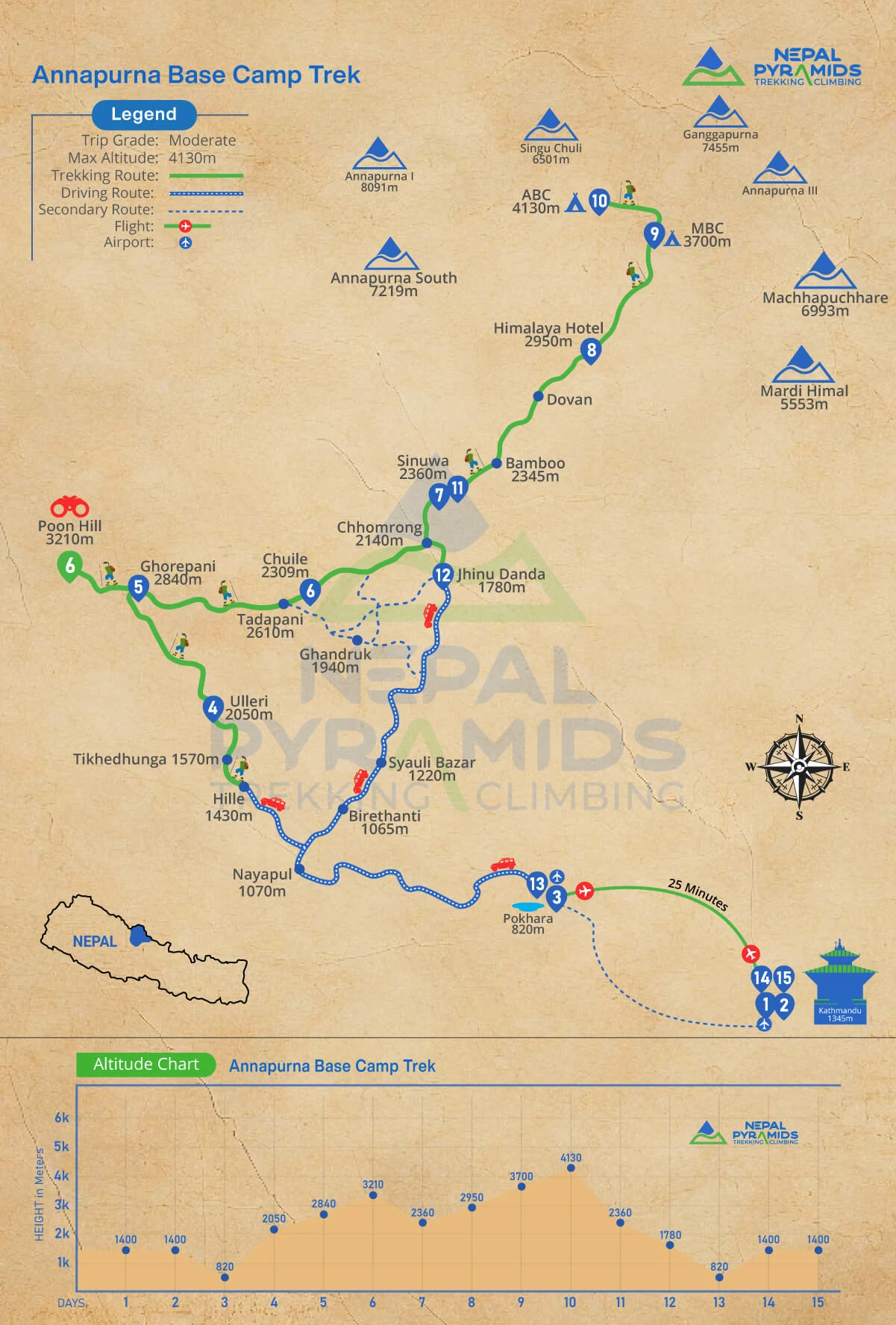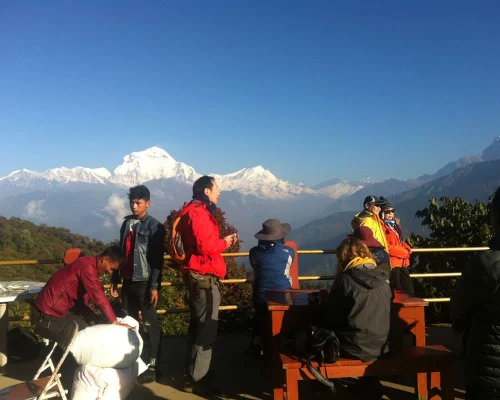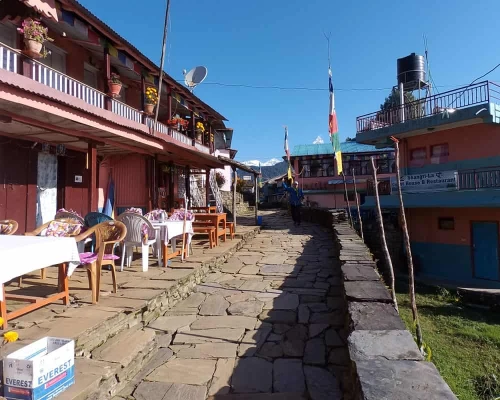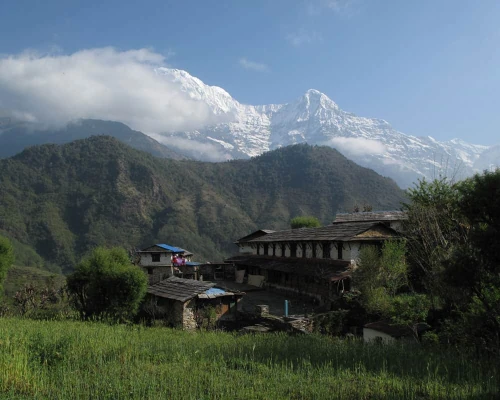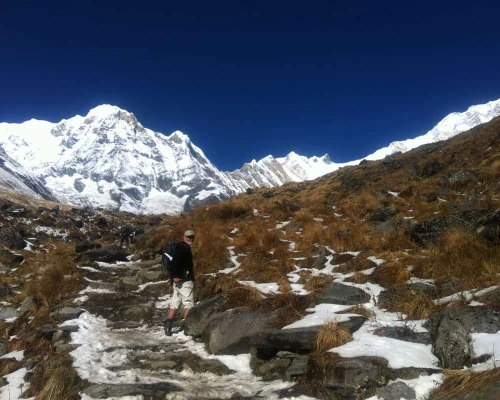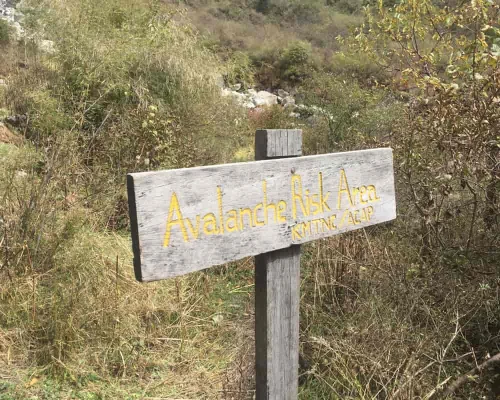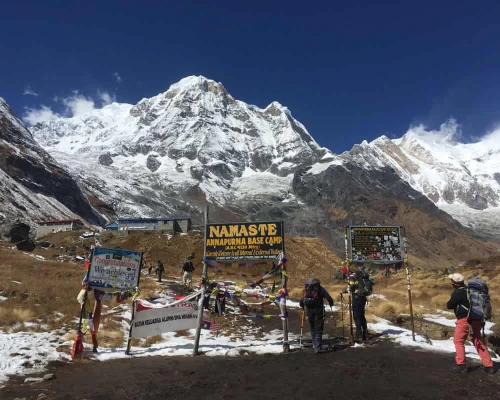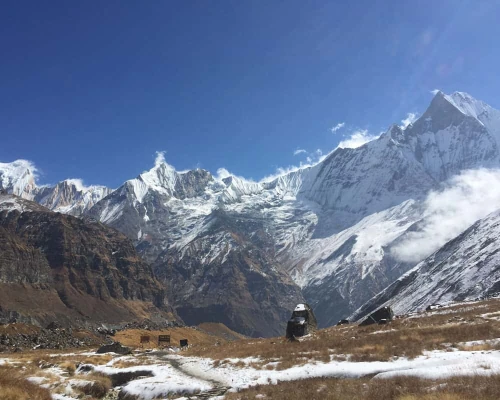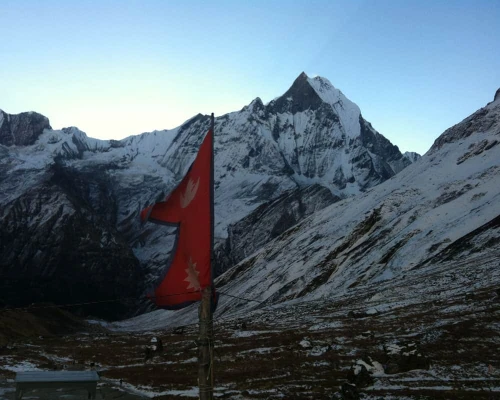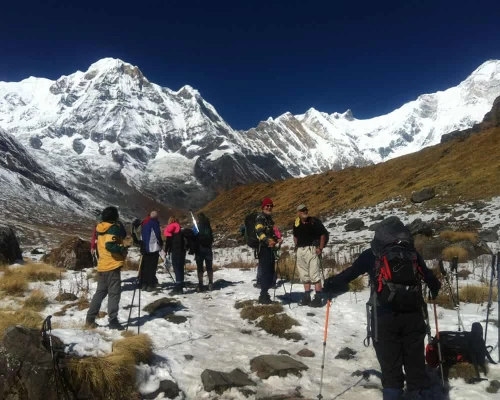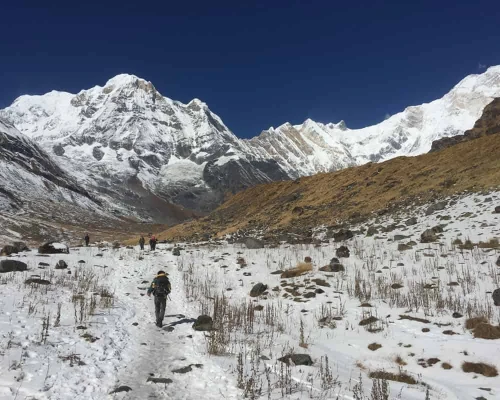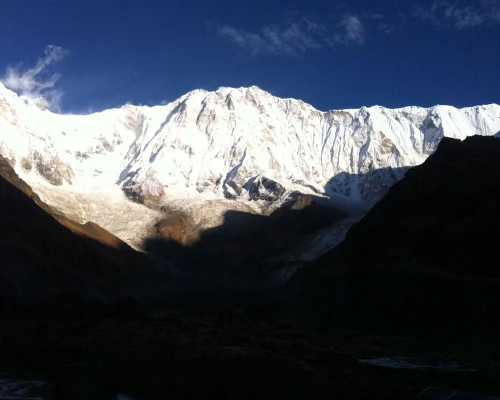More About Annapurna Base Camp Trek:
This classic TEAHOUSE trip to the Annapurna base camp trek is one of its kind among the entire Annapurna trekking category. It takes you into the divine lush woodland of Rhododendrons, pine, maple, and bamboo. The view of Mount Fishtail, a holy mountain is sensational.
Pokhara:
We start our Annapurna Base Camp trekking with a drive to Pokhara (820m), the most beautiful Lake City, and the second-largest city of Nepal. Said to be the home of the Hippie during bygone years and now the second home of the tourist, Pokhara is incredibly enchanting.
Pokhara offers a magnificent view of mountains that includes Annapurna South (7219m), Annapurna I (8091m), Hiunchuli (6441m), Machhapuchhare (6997m), Annapurna III (7555m), Annapurna IV (7525m), Annapurna II (7937m), Lamjung Himal (6983m) and other.
Trail, People and Culture:
Soon we start with our adventure into the magical valley of Annapurna. A walk following the Modi River through basic yet beautiful villages with tea houses gives you a sense of real trekking. Meet the GURUNGS, the indigenous ethnic group that have a strong presence in the Annapurna region. The Gurung culture, the village setting, the craftsmanship, and their religion mixed with their own animistic cult are certainly very mesmerizing.
We walk the most beautiful forested trail of Rhododendrons, Bamboo, Maple, and oak, also known as the "lord of the Rings trail". Gradually we go past settlements like Chhomrong, Sinuwa, and Bamboo, and eventually, get to Machhapuchar Base Camp (3700m / 12,139 feet) or MBC.
Overnight at this picturesque Machapuchare Base Camp is simply magical. It's a quiet place where you can enjoy the surroundings in absolute serenity. You will witness the holy Machapuchare (Mt. Fishtail) from a different angle which looks more like a Matterhorn. The next morning we will leave MBC and walk the most stunning Himalayan meadow to get to Annapurna Base Camp.
After our memorable time at ABC, we will follow the Modi Khola (river) and retrace our trail back to Chhomrong. Gradually we will descend to the village of Jhinu Danda (1780m) to the natural hot spring to relax our tired muscles. Once we get back to Pokhara you will have ample time to try other adventurous activities like - Paragliding, Zip-Lining, Bungee Jumping, kayaking, and many more.
Permits Required for ABC Trek:
1. Annapurna Conservation Area Project (ACAP) Permit.
The ACAP permit is mandatory for all trekkers entering the Annapurna region. This permit is crucial for the conservation and sustainable development of the area. ACAP is valid for single entry and covers the duration of the trek.
For all Foreign Nationals: NPR 3000 (approximately USD 23)
For SAARC Nationals: NPR 1000
Local Nepali Nationals: NPR 100 (as an entrance fee)
Nepal Tourism Board office in Kathmandu or Pokhara
2. Trekkers' Information Management System (TIMS) Card
The TIMS card is in the process of reintroduction for all trekking regions in Nepal from the Autumn season of 2024 which was on halt till date after COVID-19.
- Required documents for the above permits:
Passport
Passport-sized photographs (usually 2)
NOTE: Children below 10 years will not require any of these permits.
Accommodation Expectations at Annapurna Base Camp Trek:
The accommodation along the Annapurna Base Camp Trek is pretty basic. You may not have the luxury of private rooms in the teahouses. As you venture beyond the village of Sinuwa you enter the main Annapurna Sanctuary valley where things start getting simple and basic.
This is because, due to environmental concerns the Annapurna Conservation Area Project (ACAP) prohibits the construction of new teahouses in the region. This restriction aims to preserve the delicate Himalayan ecosystem and the natural beauty of the area. Due to this Environmental concern, the region beyond Sinuwa is also not allowed to use wood as fuel so trekkers will notice the absence of wood chimneys here.
All the teahouses we have now in the region beyond Sinuwa are subject to strict regulations, including limitations on room numbers and building structures. These existing lodges are not permitted to extend beyond nine rooms or construct multi-story concrete buildings. This is the reason why the teahouses here offer dormitory-style accommodations to maximize space and serve more trekkers.
During peak trekking seasons availability of private or single room options may be impossible. Few teahouses may offer this option but since the season time is the only for these teahouses to earn and pay off their rent and sustain, they may tend to go with dormitory options.
That’s why, trekkers are requested to be prepared for the possibility of sharing dormitory rooms with fellow hikers from around the world. Though this sounds very challenging there aren't many options, however, the trekkers have actually found this memorable experience. We request all our fellow trekkers that understanding the simplicity of these lodges is part of the authentic Himalayan trekking experience.
Scenic Routes to Annapurna Base Camp.
Our Annapurna Base Camp Trek itinerary goes via the famous Ghorepani Poon Hill which already makes it the most scenic route. This inclusion of Poon Hill offers you one of the most grandiose view of the Annapurna and Dhaulagiri ranges including the view of the world’s deepest gorge. The presence of this route in the initial section makes the ABC trek even more breathtaking.
However, for the trekkers seeking more scenic routes, there's an option to include the Mardi Himal route in your ABC trek. The Mardi Himal route is a newly opened trekking destination that is less trodden by the people. From the Mardi Himal route you will have a remarkable view of the mountains from a different angle.
Besides you will be rewarded with one of the most stunning sights of the valley landscapes that is found nowhere. Here the holy Machhapuchare stands like a guarding keeper that protects the entire valley. Besides the forested trail to Mardi Himal is very enchanting.
Combining Poon Hill or Mardi Himal in the classic ABC trek creates a most scenic Annapurna experience. This combination will not only take you to the most spectacular vantage points but also allows you to enjoy diverse landscapes and regions ecology.
MBC & ABC (Machhapuchare Base Camp / Annapurna Base Camp):
Machhapuchare Base Camp (MBC) is situated at the lap of the holy Fishtail Mountain at the height of 3700 meters which is 12,139 feet. MBC is extraordinarily beautiful and overnight at this picturesque place is the experience of a lifetime. The journey to Machhapuchhre Base Camp (MBC) is an introduction to the natural glory of the region. The iconic Holy Fishtail Mountain (Machhapuchhre) stands very close with its unique fishtail shape peak piercing the sky.
At MBC, you find yourself in a natural stadium completely surrounded by snow-capped mountains. Here you are surrounded by raw beauty where you will find absolute tranquility. It is a place where nature directly speaks to your soul. As the setting sun paints Machhapuchhre's slopes it creates a magical moment giving you the experience of Nepal’s majestic wilderness.
A short gradual walk from MBC into the wide Himalayan meadow takes us to our final destination of Annapurna Base Camp (ABC) (4130m / 13,549 feet). Though this walk is short, it will leave a lasting impression since the beauty of walking this section is remarkable.
At ABC everyone feels very spiritual and at peace to be at a point completely surrounded by the majestic mountains and blanketing you under its shelter.
At the base camp when the sunrise climbs over the holy mountain and spreads its light over the majestic peaks of Annapurna it appears very dramatic and phenomenal. The base camp itself reflects so much charm with memorials, prayer flags, and ample spots for photography.
How to Avoid Altitude Sickness on Annapurna Base Camp Trek?
Altitude sickness or Acute Mountain Sickness (AMS), is less likely to occur on the Annapurna Base Camp (ABC) trek. There has not been much record of severe altitude sickness on the ABC trek as compared to some other high-altitude treks.
Trek to Annapurna Base Camp begins at a relatively low elevation of 1400m or 1900m. The altitude gain is very gradual which allows trekkers to acclimatize properly in the thin air. However, ABC is at a height of 4,130 meters which is 13,550 feet, so there is a potential risk of AMS.
Below are a few preventive measures to avoid Altitude Sickness:
- Always ascend slowly as trekking is not a competition.
- Maintain your body with adequate fluid. Stay hydrated throughout the day.
- Avoid alcohol intake rather focus on rehydration.
- Ensure you're getting enough sleep each night.
- Consider taking Diamox (Acetazolamide) 250mg per day to get away with early symptoms of AMS
- Don’t push yourself too hard, listen to your body.
- Descend immediately if you experience severe symptoms.
For more detail on the prevention of Altitude Sickness while trekking in Nepal - CLICK HERE.
Here is detailed information on Medicine to Carry While Trekking in Nepal.
When is the best time to trek to Annapurna Base Camp?
The best times to trek to Annapurna Base Camp (ABC) are the traditional seasons of Spring and Autumn. Spring (March to May) and autumn (September to November) are believed to offer the most favorable conditions for trekking.
So far these traditional season is assumed to deliver clear skies, blooming Rhododendrons, moderate temperature, stable weather, and good visibility.
Monsoons are not considered favorable for the ABC trek due to the high rainfall in the region. The Annapurna region receives the highest rainfall in Nepal. There can be an increased risk of landslides, road blockage, or domestic flight cancellation. Besides leeches and other monsoon insects make things worse.
Winter season is becoming more trendier for trekking in Nepal since Climate Change is reshaping the trekking season of Nepal. Now winter is becoming more favorable for trekking delivering more beautiful weather with clear skies. Despite extreme chill, winter provides great day and night skies, and spectacular sunrise and sunset views.
However, there are a few challenges when it comes to trekking to Annapurna Base Camp in winter. There is a section before Machhapuchhre Base Camp which is an avalanche-prone area. If there is heavy snowfall in the area it will make the trek riskier. There have been a few incidents that have cost the lives of trekkers in that section.
So with heavy snowfall, you might have to abort the trek which can be disappointing. However, trekkers are trekking to ABC even in winter with safety vigilance and well-prepared for the extreme chill.
RELATED INFORMATION
Kathmandu to Pokhara Drive information:
Driving from Kathmandu to Pokhara is a popular and scenic route that takes you from the bustling capital city of Nepal to the serene and picturesque city of Pokhara, nestled in the Annapurna region.
The journey covers a distance of approximately 200 kilometers and can take around 6 to 8 hours, depending on road conditions and traffic. The drive offers breathtaking views of the Himalayan mountains, terraced fields, and lush landscapes. However, it's important to be prepared for winding and sometimes bumpy roads, so a comfortable vehicle and a skilled driver are essential.
Along the way, you'll pass through charming towns and villages, providing a glimpse of rural Nepali life. Be sure to stop at viewpoints, such as Malekhu and Muglin, to capture the natural beauty on camera.
The Prithvi Highway connects the two cities, and numerous restaurants and rest areas are available for breaks and refreshments. The journey is not just a means of getting from one place to another but an adventure in itself, offering a taste of Nepal's diverse landscapes and cultures.
Caution before Driving from Kathmandu to Pokhara
Driving from Kathmandu to Pokhara can be an adventurous and rewarding experience, but it also comes with certain challenges and difficulties that tourists should be aware of:
- Road Conditions: The road between Kathmandu and Pokhara, known as the Prithvi Highway, can be quite challenging. While some sections are well-maintained, others may be in poor condition, especially during the monsoon season. The road is winding and can be bumpy, so travelers may experience discomfort, especially if they are not accustomed to such road conditions.
- Traffic and Congestion: Traffic congestion along this narrow highway especially around the Kathmandu Valley and the Muglin Narayanghat section, can lead to delays. The road can get crowded with vehicles, making it essential to plan for extra travel time.
- Landslides and Natural Disasters: The region is prone to landslides, particularly during the monsoon season. Travelers should check weather and road conditions before embarking on the journey and be prepared for possible delays or route changes in case of natural disasters.
- Local Driving Habits: Driving habits in Nepal can be different from what tourists are accustomed to. Even in the narrow roads Drivers OVERTAKING and HONKING HORNS are very common which can be a great cultural shock.
Flight from Pokhara to Kathmandu
The scenic flight from Pokhara to Kathmandu is a breathtaking journey that summarizes the incredible natural beauty and geographic diversity of Nepal. As the aircraft gracefully ascends from Pokhara's domestic airport, Travelers are immediately captivated by the unparalleled vistas below.
The sight of the towering Annapurna and Dhaulagiri mountain ranges, with their pristine snow-clad peaks, stretches out before your eyes. The flight provides an intimate perspective on these enormous giants, revealing their sheer magnitude and splendor.
Flying over the deep valleys and terraced hillsides, you witness a mesmerizing tapestry of Nepal's landscapes, a fusion of vibrant greenery and snow-dusted summits that's unlike anything else on Earth.
The journey from Pokhara to Kathmandu takes you on a visual pilgrimage, providing an extraordinary glimpse of the Nepalese countryside, with its charming villages, twisting rivers, and lush forests.
As the flight progresses, you begin to sense the transition from the serene Pokhara to the vibrant, bustling Kathmandu Valley.
This aerial adventure is not just a means of transportation; it's a window into Nepal's soul


